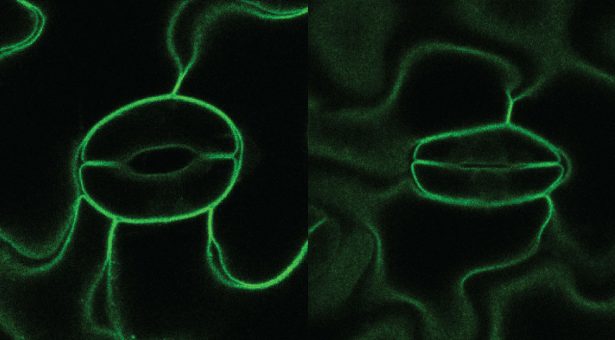The breathtaking dance of plants

The spacing of stomata, the pores through which plants breathe, is key to maximising the plant’s breathing and how this spacing was achieved has, until now, been a mystery.
Publishing in Science, John Innes Centre researchers have combined imaging and modelling to uncover the mechanism behind it.
The way in which plants space out the pores through which they breathe depends on keeping a protein active during stem cell growth.
Plant pores, called stomata, are essential for life. When they evolved about 400 million years ago, they helped plants conquer the land.
Plants absorb carbon dioxide through stomata and release oxygen and water vapour as part of the Earth’s carbon and water cycles.
Stomata need to be evenly spaced to maximise breathing capacity. But how they establish an even spatial pattern during plant growth has been a mystery.
In a paper to be published in Science, the scientists show that the ability of cells to divide and form stomata is retained in only one of the two daughter cells generated by each division.
This pattern, known as stem cell behaviour, is also found in certain animal cells, like those that form skin or bone.
In the case of stomata, the stem cell property depends on a protein called SPEECHLESS (SPCH) being kept active in a single daughter cell. The daughter cell is kept at the centre of her cellular relatives through a sort of molecular dance through which the polarity of cells switches at each division. The daughter eventually forms a stoma, surrounded by non-stomatal relatives, ensuring that the stomatal pores are spaced out.
“Unravelling this mechanism was only possible because of advances in live imaging and computational modelling,” said Professor Enrico Coen, the plant science centre strategically funded by the Biotechnology and Biological Sciences Research Council.
The computer modelling predicted rules that the scientists were able to validate experimentally in the plant Arabidopsis. They tracked various markers such as a fluorescent protein to see the patterns that formed in growing leaves.
The research could help scientists to tailor the number and arrangement of stomata to different environments. This could regulate the efficiency at which plants absorb carbon dioxide or diffuse water vapour.
The work was funded by BBSRC, the Natural Sciences and Engineering Research Council of Canada and the US National Institutes of Health.



